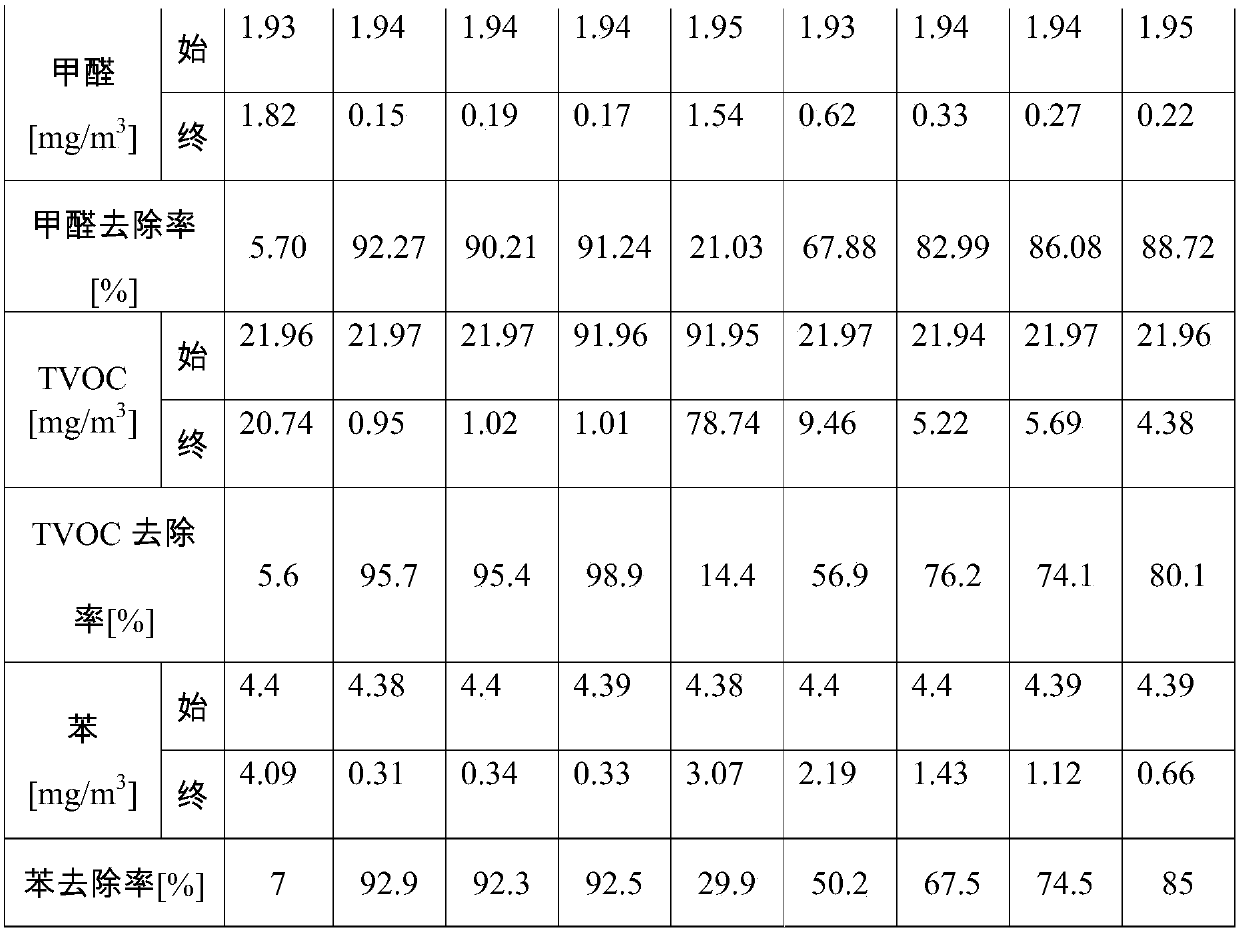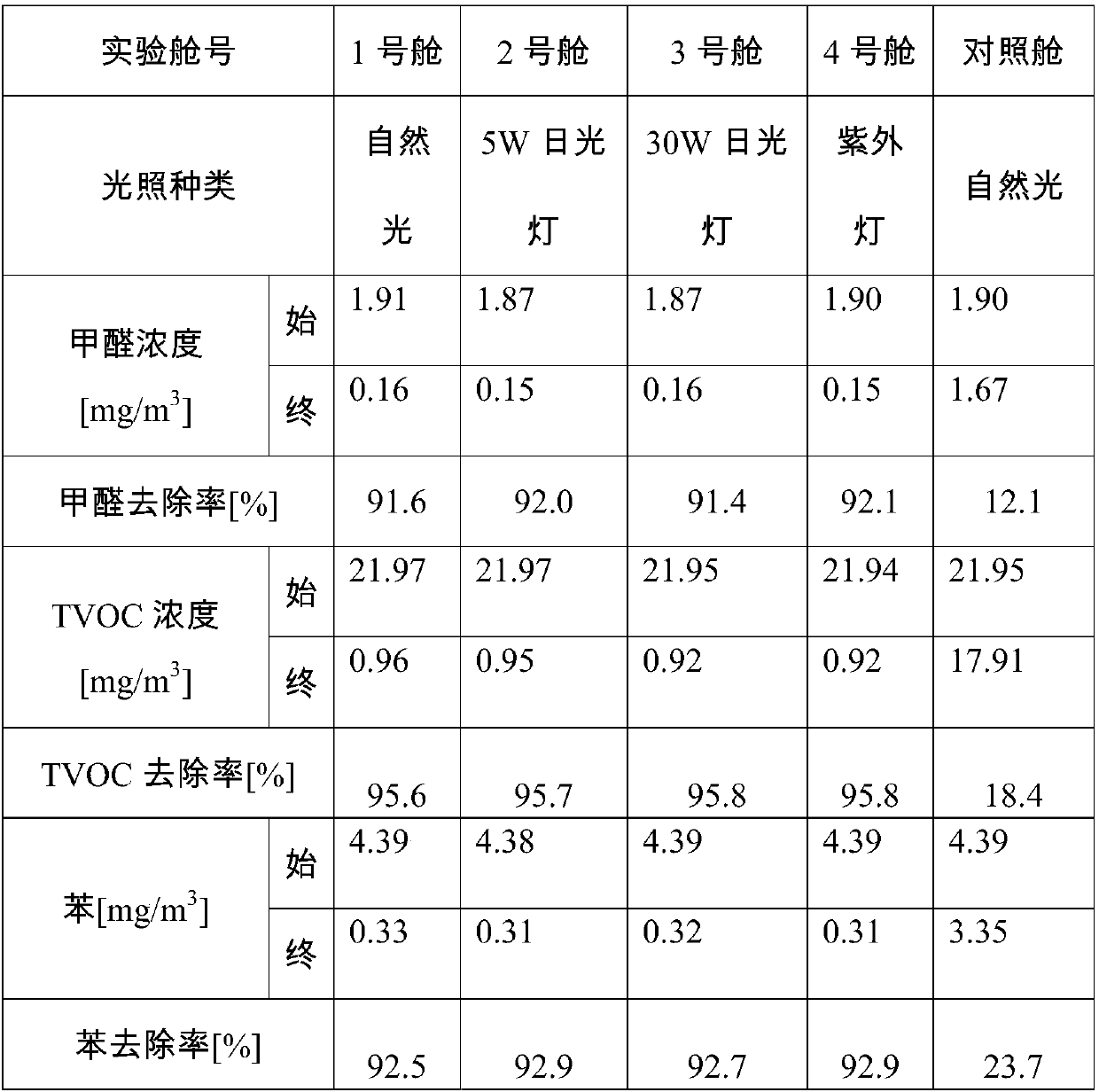Anionic type photocatalyst and preparation method thereof
A technology of photocatalyst and negative ion, which is applied in the field of negative ion photocatalyst and its preparation, can solve problems such as hindering the application of photocatalyst TiO, difficult catalytic degradation, high chemical redox potential, etc., to increase contact time and contact area, promote catalytic degradation, improve The effect of catalytic efficiency
- Summary
- Abstract
- Description
- Claims
- Application Information
AI Technical Summary
Problems solved by technology
Method used
Image
Examples
Embodiment 1
[0045] A negative ion photocatalyst, comprising the following components by weight: 90 parts of titanium dioxide, 20 parts of auxiliary agent, 0.5 part of tourmaline powder, 2 parts of ferrocene, 40 parts of diatomaceous earth and 20 parts of clay; Metal platinum is deposited on the surface of titanium dioxide, and the loading capacity of the metal platinum on titanium dioxide is 0.005g / g; The impurity is 6 mol%; the clay is sepiolite; the tourmaline is ferrite.
[0046] The method for preparing this negative ion photocatalyst comprises the following steps:
[0047] 1) Preparation of cerium-nitrogen co-doped titanium dioxide;
[0048] a) 34g of butyl titanate (0.1mol) and 5mL of acetylacetone were added into 80mL of ethanol to dissolve to obtain a titanium precursor;
[0049] b) Add 0.054g of cerium nitrate (0.1mmol), 1mL of glacial acetic acid, and 0.36g of urea (6mmol) into 10mL of ethanol to dissolve, add dropwise to the above titanium precursor solution, and stir; adjust...
Embodiment 2
[0055] A negative ion photocatalyst, comprising the following components by weight: 100 parts of titanium dioxide, 10 parts of auxiliary agent, 0.1 part of tourmaline powder, 5 parts of ferrocene, 30 parts of diatomaceous earth and 30 parts of clay; Metal platinum is deposited on the surface of titanium dioxide, and the loading capacity of the metal platinum to titanium dioxide is 0.01g / g; The impurity is 8mol%; the clay is attapulgite; the tourmaline is silver gray tourmaline.
[0056] The method for preparing this negative ion photocatalyst comprises the following steps:
[0057] 1) Preparation of cerium-nitrogen co-doped titanium dioxide;
[0058] a) Add 34g of butyl titanate (0.1mol) and 5mL of acetylacetone into 80mL of ethanol and dissolve to obtain a titanium precursor;
[0059] b) Add 0.027g of cerium nitrate (0.05mmol), 1mL of glacial acetic acid, and 0.48g of urea (8mmol) into 10mL of ethanol to dissolve, add dropwise to the above titanium precursor solution, and s...
Embodiment 3
[0065] A negative ion photocatalyst, comprising the following components by weight: 80 parts of titanium dioxide, 2 parts of tourmaline powder, 1 part of ferrocene, 50 parts of diatomaceous earth and 1 part of clay; the titanium dioxide is cerium-nitrogen Co-doped titanium dioxide, the doping amount of cerium is 0.5 mol%, and the doping amount of nitrogen is 5 mol%; metal platinum is deposited on the surface of the titanium dioxide, and the loading capacity of the metal platinum on the titanium dioxide is 0.01g / g; The clay is kaolin; the tourmaline is iron tourmaline and silver gray tourmaline mixed in a weight ratio of 1:1.
[0066] The method for preparing this negative ion photocatalyst comprises the following steps:
[0067] 1) Preparation of cerium-nitrogen co-doped titanium dioxide;
[0068] a) Add 34g of butyl titanate (0.1mol) and 5mL of acetylacetone into 80mL of ethanol and dissolve to obtain a titanium precursor;
[0069] b) Add 0.27g of cerium nitrate (0.5mmol), ...
PUM
 Login to View More
Login to View More Abstract
Description
Claims
Application Information
 Login to View More
Login to View More - R&D
- Intellectual Property
- Life Sciences
- Materials
- Tech Scout
- Unparalleled Data Quality
- Higher Quality Content
- 60% Fewer Hallucinations
Browse by: Latest US Patents, China's latest patents, Technical Efficacy Thesaurus, Application Domain, Technology Topic, Popular Technical Reports.
© 2025 PatSnap. All rights reserved.Legal|Privacy policy|Modern Slavery Act Transparency Statement|Sitemap|About US| Contact US: help@patsnap.com



